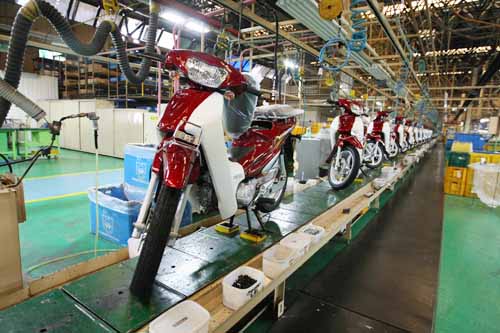Korean motorcycles face falling market

Daelim Motor’s production line in Changwon came to a halt due to a strike earlier this month. Korean motorcycle manufacturers are facing a critical situation due to declining sales and increased competition from Chinese and Taiwanese bikes. By Song Bong-geun
The plant used to produce one motorcycle every 60 seconds. On the day we visited, however, motorcycles were covered in vinyl and only a few motorcycle parts production lines were active.
“This year our stockpile has shot up to around 6,500 units,” said So Jung-seop of Daelim’s corporate structure improvement team.
“All we do is reassemble motorcycle parts that have received complaints from customers,” said Chung Hyun-so, who works at the Changwon plant. “The government should not only help improve the automotive and bicycle industries but the motorcycle industry as well.”
Companies like Daelim and S&T Motors face steep competition from foreign companies. Imported motorcycles take up 30 percent of the Korean market.
On a recent visit to S&T Motors, there were roughly 1,000 motorcycles still waiting to be shipped out of the factory. The company has an annual production capacity of 50,000 motorcycles. This year, however, the company is likely to produce just 25,000 units.
Korean motorcycle manufacturers are facing a crisis. Not only have they missed the opportunity to enter the high-end leisure motorcycle market but they are also facing fierce competition from low-end Chinese motorcycles. According to the motorcycle industry, Korean motorcycle manufacturers had record sales of 308,000 units in 1995. However after the financial crisis in the late 1990s, sales dropped to more than half, with motorcyclists preferring to buy cheaper Chinese and Taiwanese motorcycles.
In recent years Korean motorcycle companies have recorded annual sales of between 150,000 to 200,000 units. The market for high-end leisure motorcycles priced at over 10 million won ($8,500) has been dominated by imports since 2000, causing local companies to lose ground. Instead, they have focused on developing small motorcycles and scooters for small businesses.
Meanwhile, the imported motorcycle market has continued to grow. In 2003 imported motorcycles accounted for just 10 percent of the motorcycle market in Korea. Last year it rose to 30 percent. Among the motorcycles imported, those manufactured in China and Taiwan comprise more than 70 percent of imports.
Korean companies have also failed to expand their exports, losing the price war to China, which ships a large number of low-end motorcycles to Southeast Asian markets including Vietnam and Thailand.
Daelim’s motorcycle exports, which consisted of 116,146 units in 1999, dropped 84.6 percent last year to 17,845 units.
This is a stark contrast to Japanese motorcycle manufacturers, which have stayed competitive in part by building motorcycle plants in Southeast Asia.
The industry is expected to lose additional ground when the Korean government adopts a registration system for motorcycles with an engine displacement of under 50 cc in 2010.
A plan to implement a driver’s license system for motorcycles under 50 cc in 2011 could also affect sales.
By Kim Tae-jin, Hwang Sun-yoon [ojlee82@joongang.co.kr]










with the Korea JoongAng Daily
To write comments, please log in to one of the accounts.
Standards Board Policy (0/250자)